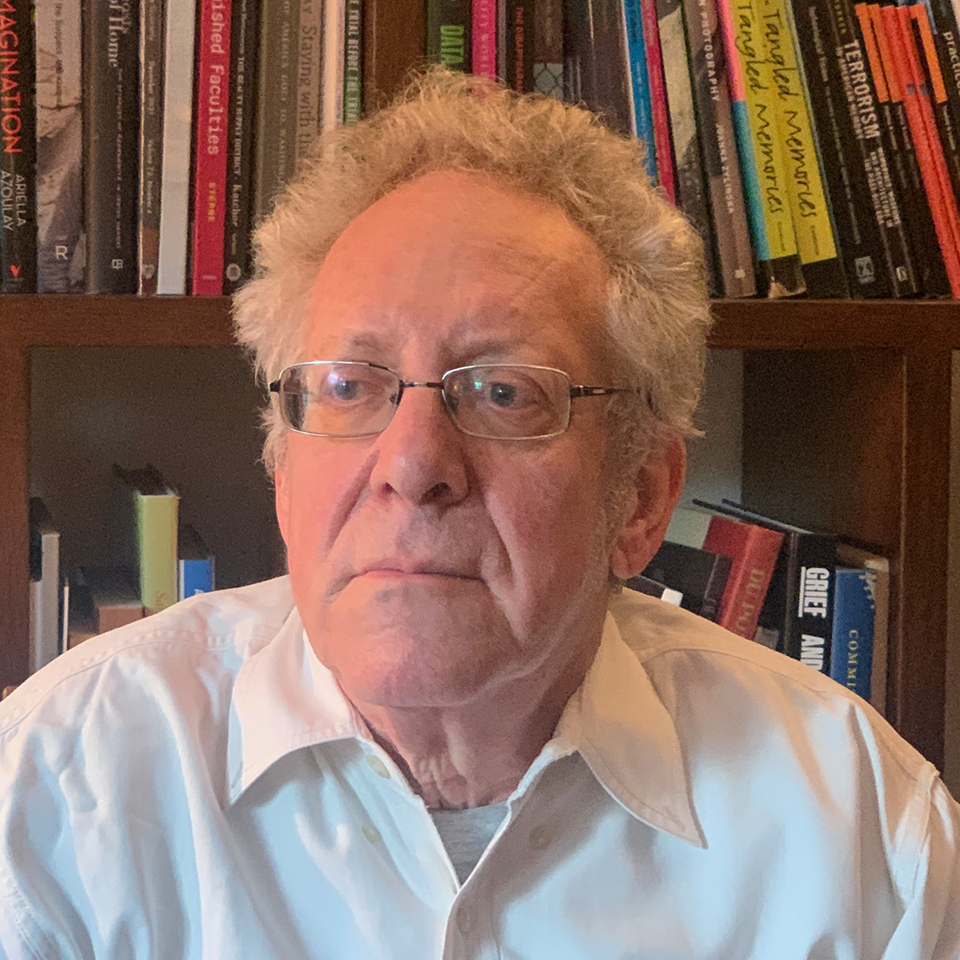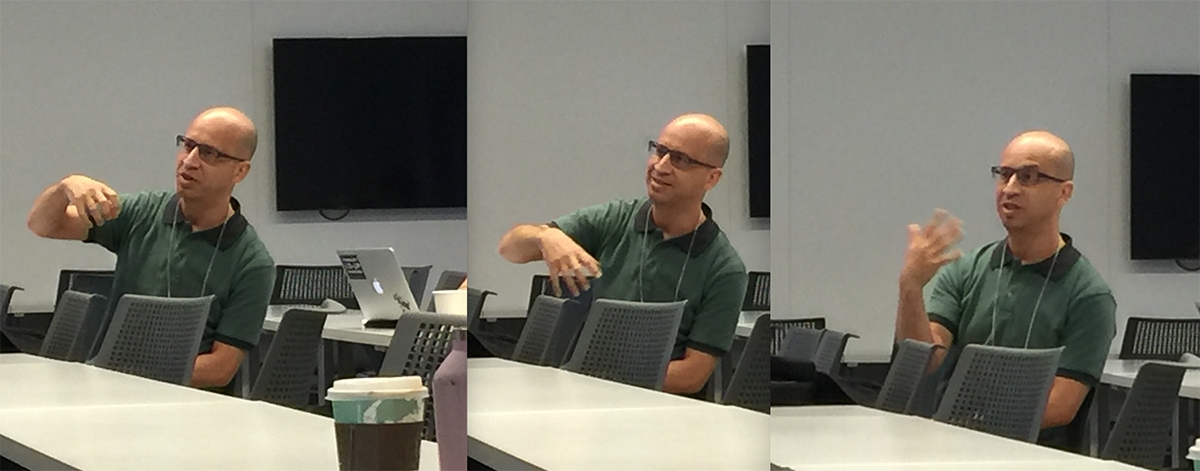My friend and former department colleague, Jonathan Kahana, has passed away after a fight with lung cancer. When he was recruited to UC Santa Cruz, Jonathan asked me to write a recommendation on his behalf. I didn't want Jonathan to go but I always want what is best for my friends, and the UCSC appointment for him and his beloved partner Jenny Horne, was a wonderful opportunity. Jonathan was so happy in Santa Cruz, professionally and personally, and he flourished there. The following comments derive from the letter I wrote for him. That letter doesn't account for Jonathan's profound accomplishments since he left NYU in 2012, but I wanted to say something right away about Jonathan and his scholarly contributions. To bring Jonathan's accomplishments more up to date, I've interpolated some lines from John Belton, one of Jonathan's earliest and beloved mentors, who wrote on his behalf for Jonathan's proposal to the NEH for his project on screen reenactment and the work of the past, Going Through the Motions: Screen Reenactment and the Work of the Past.
Jonathan Kahana was a friend of mine as well as a cherished partner in on-going intellectual exchange. I first met him when we had both just been hired by NYU (and were about to begin our positions there, along with mutual friend Dan Streible), and from the start I was struck by Jonathan's combination of sharp critical thought and affable enthusiasm. In fact, in the case of Jonathan, I feel in large part that I welcomed him as a friend because it was so easy for me to respect him as a thinker with great commitment to the life of the mind and great ability to manifest that commitment in productive dialogue and scholarly work. Much of what I liked about him personally connected to the profound admiration I had for his sharpness of mind and his intensity of insight.
Jonathan conducted all his academic endeavors with deep reflection and productive illumination. He made important contributions to scholarship in film, media, contemporary critical thought, and connected areas. Jonathan enjoyed a world-wide reputation as one of the very best historians and interpreters of non-fiction modes of visual communication. His breakthrough study on the form, Intelligence Work, in very short time attained virtually classic status as one of the key works for the field and, to my mind, it has not been matched in depth and breadth by any subsequent research by other scholars in the field. Combining meticulous archival research – on both documentary itself and on the discourse around it of the critical establishment – with a sharp understanding of the political economy behind documentary industry, Jonathan basically revolutionized the study of this important area of cinema.
At the risk of simplifying the far-reaching arguments of a book with many important stakes, I would say that Intelligence Work set out to examine how key works from the history of American documentary worked to make visible consequential and often fraught issues of contemporary life and address ordinary citizens in the byways of the world around them. The title, as Jonathan clarifies, alludes to Walter Lippmann’s (in)famous assessment of the role of media in democracy and his assertion of the need for experts – workers in the realm of intelligent reflection – to mediate political ideas and everyday citizenship. Jonathan’s goal was to address Lippmann’s idea critically and examine the extent to which documentaries offer top-down pedagogy or can, in contrast, constitute a form of popular, democratic knowledge that arises from citizens themselves. Central to Jonathan’s argument in Intelligence Work is the notion of “allegory,” typically thought of as a strategy of works of fiction, but employed by Jonathan to capture something particular about the workings of documentary. Specifically, Jonathan argues that documentaries may, by nature of their origin in a photographic medium, render the facts of a specific here-and-now but in the best of cases they transcend that specificity by allegorical interpretation that asserts broader implications around particular events. Jonathan thus sees the documentaries that he deals with as both specific and general, and this grants them their especial power in the public realms (from movie theaters to television channels) where they are exhibited. As Jonathan asserts, his volume is a contribution both to cinema studies in particular and to American studies more generally, insofar as he is concerned to pinpoint the social and cultural roles key documentaries have had in airing and articulating pressing concerns of U. S. political and personal life. Toward this end, his volume offers readings not just of films but of myriad forms of American cultural expression, from the popular press to government documents to works of literature.
Additional marks of his reputation in the area abound: for instance, a major independent distributor, Image Entertainment, commissioned him to write the liner notes for the DVD edition of the important Emile de Antonio non-fiction film, Underground (1976). Likewise, Oxford University Press commissioned him to put together a reader of primary texts from the history of non-fiction film. Such a volume was much needed and is now the go-to anthology for documentary studies.
In recent years, Jonathan elaborated a series of upcoming projects, several of them book-length. The breadth of these projects – from the role of witnessing in film to the sonic and aural dimension of visual media to performance issues in cinema – attests to an energetic engagement in scholarship of a very promising and committed sort, so tragically cut short.
From John Belton: " Jonathan’s long-standing interest in documentary film, especially contemporary (i.e., post-World War II) documentaries, led him to the mode of reenactment as a topic for his next book. Reenactment has always been an integral element of the documentary from the early reenactments of the Battle of Manila in the Spanish-American War (Tearing Down the Spanish Flag, 1898) to classic documentaries such as Nanook of the North (1922), a film that was re-staged after director Robert Flaherty’s original footage, shot in 1914-15, was accidentally destroyed. As Jonathan noted, reenactment in documentary, once a staple of the genre, fell into disrepute in the 1960s with the advent of cinema verité and its emphasis on the observational recording of events as they occurred. It was the reemergence of the reenactment mode in the late 1980s that caught Jonathan’s attention. This reemergence can be seen most dramatically in Errol Morris’s Thin Blue Line (1988) which reenacts crucial events from the often conflicting perspectives of different witnesses, and in the aftermath of the 9/11 attack on the World Trade Center, as exemplified in ABC’s infamous docudrama The Path to 9/11 (2006), which was widely criticized for its historical inaccuracies and for the inclusion of events that never occurred. Jonathan’s argument links the revival of this mode to a variety of factors, ranging from cultural anxieties about representing traumatic events of the recent past to the ultimate unrepresentability of those events (as is the case with certain films about the Holocaust). Caught between a desire to represent and the fear that any representation they might make would necessarily be false, filmmakers resorted to reenactment, a mode which acknowledges its own status as a representation. This, in turn, leads Jonathan to the notion of irony, the dominant mode of address that characterizes these films. As he so succinctly put it, 'reenactments are reluctant derivations of reality that resist truthful, prepossessing expression, and . . . irony is thus the pervasive trope of reenactment.' This, in turn, has political consequences that distinguish contemporary works of reenactment from those of the classical and pre-classical era. Jonathan thus quotes Hayden White’s Metahistory, noting that irony 'tends to dissolve all belief in the possibility of positive political actions.' I find Jonathan’s thesis extremely perceptive, providing a fascinating account of the contemporary documentary’s recent turn from its traditional appeals to the real to more modern and postmodern notions of the impossibility of any real. Jonathan also saw this turn as a solution to the so-called 'digital dilemma.' If the advent of digital imaging and its potential for infinite manipulability undermines any possibility of an indexical relationship the image might have with its referent (and thus, as Jonathan put it, the image’s 'purchase on truth'), the turn to reenactment, which acknowledges the image as a simulation, can more effectively express the 'truth' of digital imaging—which is a form of simulation--than can traditional analog imaging. As a result, Jonathan’s book, as he himself noted, 'positions moving-image reenactment between truth-telling and fictive or fantastic modes of representation, a mode that can be found across the entire range of moving-picture forms of the twentieth century, from historical narrative to documentary, propagandistic and instructional forms to experimental uses of film and video.'"
It is important to note that Jonathan produced this important and consequential body of scholarly work while giving much of his time with great enthusiasm and energy to his teaching and to university and disciplinary service of a deep and varied sort. His intellectual investments in program and curricular development were deeply impressive. Already, as a former director of the Bryn Mawr film studies program, Jonathan came to NYU with great awareness of curricular issues in cinema studies and of the role of close mentoring of students in a field that, within the larger university context, has had often to struggle for academic legitimation. Jonathan’s courses for us were marked by rigor and seriousness of purpose (as a minor example, he was famous for a deep commitment to building student writing skills that manifested itself in extensive comments on papers that went well beyond the 'call of duty' around the correction of writing). As one mark of the regard with which students hold him, Jonathan was nominated for a Tisch School of the Arts teaching award.
For 2007-2008, Jonathan served as the department’s Director of Undergraduate Studies and took as part of his mission to enable our graduate students to be better teachers of undergraduates through a series of pedagogy workshops he organized. Since his arrival at NYU, he served importantly as the department’s liaison with Anthropology for our joint certificate in Culture and Media that enables students from each department to engage with cutting edge work at the edge of ethnography and moving image media.
One example of Jonathan’s service to the field at large was his work for the nominating committee of the Society for Cinema and Media Studies, the primary professional organization for the field. Famously, Jonathan initiated and implemented a major rethinking of terms and term-limits for officers that has led to more effective, more productive administration of the society.
Always, Jonathan was an engaged and engaging scholar and his enthusiasm impelled students to engage in productive interchange. Jonathan clearly understood that the best and most useful research takes place as part of an ongoing pedagogical intent in which the results of one’s efforts matter only insofar as they are shared with others, offered up to a public for reaction and inspiration. Through his wonderful balance of scholarship and pedagogy, Jonathan served as a great model of the scholar committed to research’s contributions both to the disciplinary field and to the public at large.

